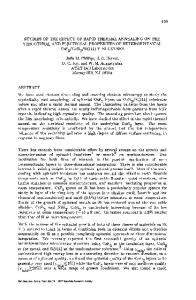Temperature Dependence Of The Electrical Properties Of Epitaxial Caf 2 Layers On Si(111) Summary Abstract
- PDF / 109,299 Bytes
- 3 Pages / 420.48 x 639 pts Page_size
- 87 Downloads / 291 Views
TEMPERATURE DEPENDENCE OF THE ELECTRICAL PROPERTIES OF EPITAXIAL CaF 2 LAYERS ON Si(111) SUMMARY ABSTRACT R.W. Fathauera and L.J. Schowalterb General Electric Corporate Research and Development Center, Schenectady, NY 12301
CaF 2
is an insulator with a number of attractive properties for
epitaxial growth on Si. 1
Epitaxial CaF2 layers have been grown on Si(111)
by Molecular Beam Epitaxy and are found to have smooth surfaces and a high degree of crystalline perfection. 1
For applications such as a gate
insulator in metal-insulator-semiconductor
field-effect transistors or in
silicon-on-insulator technology, the electrical properties of these layers are also critical. Electrical structures
characterization
of
metal-insulator-semiconductor
has been carried out at temperatures
temperature down to 80 K.
ranging from room
While room-temperature leakage in these
devices becomes large at moderate fields (0.2-0.6 MV/cm for layers of 70-430 nm thickness), there is a dramatic decrease in the current at lower temperatures.
The activation energy for the leakage is 1.1 eV for
forward biased (positive voltage on the metal) samples on n-type Si, and the breakdown field for these layers increases from 0.6 MV/cm at room temperature to 2.0 MV/cm at 80 K. There is no modulation in the capacitance with varying voltage for devices fabricated from p-type Si; however, there is modulation for devices fabricated from n-type Si.
In particular, a single value of the
capacitance (denoted Cplateau) is measured over a range of voltages, and this capacitance corresponds approximately to the Fermi level at the Si surface being located at the valence-band maximum. negative
biases, the capacitance
Mat. Res. Soc. Symp. Proc. Vol. 91. 11987 Materials Research Society
At sufficiently large
drops below this value, while at
372
large positive biases it rises to the insulator value Ci
sufficiently
(corresponding to accumulation of the Si surface).
This modulation drops
out with decreasing temperature, and at 225 K the characteristic is flat at the value Cplateau.
In addition, the dependences of the capacitance on
device area and illumination indicate that an inversion layer exists at the Si surface of devices fabricated from n-type Si. We conclude that the modulation in the C-V characteristics is driven by the leakage and that the Fermi level at the Si surface is pinned near the valence-band minimum. The decrease in the capacitance at negative voltages is thought to be due to leakage of the inversion charge. The rise to Ci at positive voltages is due to an increase in the effective area of the depletion region as a result of coupling of the ac probing signal to Si outside of the perimeter of the Al dot. found in Ref. 2.)
(Details of this model are
These results indicate that as-grown CaF 2 on Si(111) is
not suitable for gate-insulator applications.
However, the properties of process after
the interface can be altered by a rapid-thermal-annealing growth.
3
purposes
In addition, as-grown layers may be suitable for i










